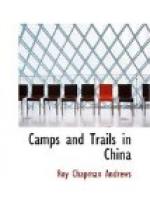Heller took a position in a bean field while I climbed to a sharp ridge above and beyond him. In less than half an hour the dogs began to yelp in an uncertain way. I saw one of them running down hill, nose to the ground, and a few seconds later Heller fired twice in quick succession. Two sambur had skirted the edge of the wood less than one hundred yards away, but he had missed with both shots.
The trail led into a deep ravine filled with dense underbrush. In a few moments the dogs began to yelp again and, while Heller remained on the hillside to watch the open fields, I followed the hounds along the creek bed. Suddenly the whiplike crack of his Savage 250-300 rifle sounded five times in quick succession just above our heads, and we climbed hurriedly out of the gorge.
Heller shouted that he had fired at a huge sambur running along the edge of a bean field but the animal showed no sign of being hit. We easily picked up the trail in the soft earth and in a few moments found several drops of blood, showing that at least one bullet had found its mark. The blood soon ceased and we began to wonder if the sambur had not been merely scratched.
Heller had seen the deer disappear in a second ravine, a branch of the one out of which it had first been driven, and while he watched the upper side I worked my way to the bottom to look for tracks. A few moments later the natives began to shout excitedly just above me, and Heller called out that they had found the deer, which was lying stone dead half way down the side of the gorge in a mass of thick ferns. The sambur had been hit only once but the powerful Savage bullet had crashed through the shoulder into the lungs; it was quite sufficient to do the work even on such a huge animal and the deer had run less than one hundred yards from the place where it had been shot.
It was a splendid male, carrying a magnificent pair of antlers which measured twenty-seven inches in length. The deer was about the size of an American wapiti, or elk, and must have weighed at least seven hundred pounds, for it required eight men to lift it. The Chinese hunters were wild with excitement, but especially so when we began to eviscerate the animal, for they wished to save the blood which is considered of great medicinal value. They filled caps, sacks, bamboo joints, and every receptacle which they could find after each man had drunk all he could possibly force down his throat and had eaten the huge clots which choked the thorax.
When the sambur was brought to camp a regular orgy was held by our servants, mafus, and dozens of villagers who gathered to buy, beg, or steal some of the blood. Our interpreter, Wu, took the heart as his perquisite, carefully extracted the blood, and dried it in a basin. The liver also seemed to be an especial desideratum, and in fact every part of the viscera was saved. Because the antlers were hard they were not considered of especial value, but had they been in the velvet we should have had to guard them closely; then they would have been worth about one hundred dollars (Mexican).




